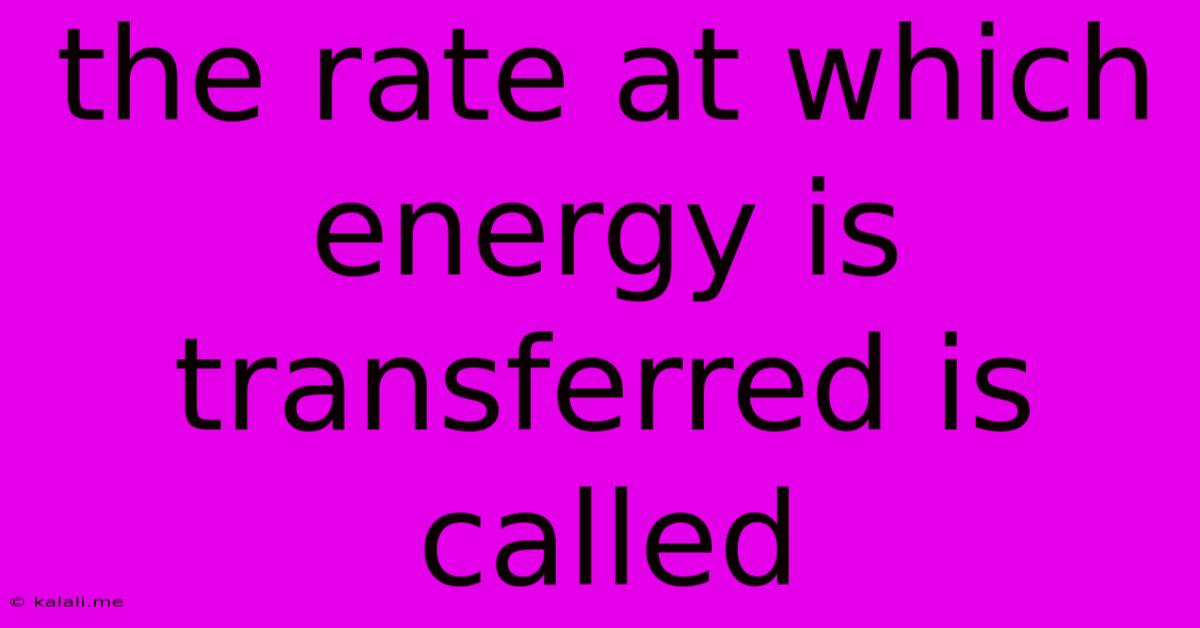The Rate At Which Energy Is Transferred Is Called
Kalali
Jun 15, 2025 · 2 min read

Table of Contents
The Rate at Which Energy is Transferred is Called: Power
The rate at which energy is transferred is called power. Understanding power is crucial in various fields, from physics and engineering to everyday life. This article will delve into the definition of power, its units of measurement, different forms of power, and real-world examples.
What is Power?
In simple terms, power measures how quickly work is done or how rapidly energy is transferred or converted. It's not just about the amount of energy involved, but also the speed at which it's used or transformed. Think of it like this: two cars might travel the same distance (same amount of work done against friction), but a sports car will do it much faster (higher power).
A more precise definition is that power is the rate of doing work, or the rate of energy transfer. This can be expressed mathematically as:
Power (P) = Work (W) / Time (t)
Or, since work is equivalent to energy (E), we can also say:
Power (P) = Energy (E) / Time (t)
Units of Power
The standard unit of power in the International System of Units (SI) is the watt (W). One watt is equal to one joule per second (J/s). Other units of power include:
- Kilowatt (kW): 1 kW = 1000 W
- Megawatt (MW): 1 MW = 1,000,000 W
- Horsepower (hp): An older unit, often used for engines and motors. 1 hp is approximately 746 W.
Different Forms of Power
Power manifests in various forms depending on the energy transfer mechanism. Some examples include:
- Mechanical Power: The rate at which mechanical work is done, often associated with machines and engines. Think of a car engine's horsepower or the power output of a pump.
- Electrical Power: The rate at which electrical energy is transferred, measured in watts. This is crucial in understanding electrical circuits and appliance energy consumption.
- Thermal Power: The rate at which heat energy is transferred. This is relevant in thermodynamics and understanding heat engines.
Real-World Examples of Power
Power is everywhere around us:
- Light bulbs: A 60-watt bulb consumes 60 joules of electrical energy per second.
- Cars: A car's engine power determines its acceleration and speed. A higher power engine can achieve higher speeds faster.
- Power Plants: Power plants generate electricity at megawatt levels, supplying energy to homes and industries.
- Human Body: Our bodies also generate power, allowing us to perform physical activities. The power output varies based on the activity's intensity.
Conclusion
Power is a fundamental concept in physics and engineering. Understanding the rate at which energy is transferred is essential for analyzing various systems and processes. From everyday appliances to large-scale power generation, the concept of power plays a vital role in our understanding of how energy works in the world around us. By grasping the definition, units, and various forms of power, we can better appreciate the energy dynamics influencing our lives.
Latest Posts
Latest Posts
-
How Would You Describe The Relationship Between Nyse And Nasdaq
Jun 15, 2025
-
The Correct Sequence Of The Phases Of Motor Development Is
Jun 15, 2025
-
93 Out Of 150 As A Percentage
Jun 15, 2025
-
Which Type Of Electromagnetic Wave Has The Greatest Frequency
Jun 15, 2025
-
What Is The Factor Of 83
Jun 15, 2025
Related Post
Thank you for visiting our website which covers about The Rate At Which Energy Is Transferred Is Called . We hope the information provided has been useful to you. Feel free to contact us if you have any questions or need further assistance. See you next time and don't miss to bookmark.